Comprehensive Literature Review: Israel and Palestine Conflict
VerifiedAdded on 2023/01/23
|5
|1260
|71
Literature Review
AI Summary
This literature review examines the history of the Israel-Palestine conflict from 1948 to 2005, focusing on border disputes and the impact of four major wars. It analyzes the arguments presented in a roundtable debate involving professionals from Israel, Palestine, and international groups. The review highlights the author's expertise in the land issue and alienated politics, suggesting that the conflict could end with the decolonization of Israeli-occupied Palestinian lands. The author supports arguments with empirical evidence, discussing the historical claims of both Jews and Arabs, the role of the UN, and the impact of political conflict in the 20th century. The study considers bias, referencing viewpoints on radicalism, violence, and the media's portrayal of the conflict. The sources contribute to understanding the causes of the conflict, including the desire for a Jewish homeland after the Holocaust and the ongoing fighting over Gaza. The conclusion emphasizes the land issues, Israeli settlements, and the need for Israel to return land occupied in the 1967 war. The assignment includes a bibliography of relevant sources.
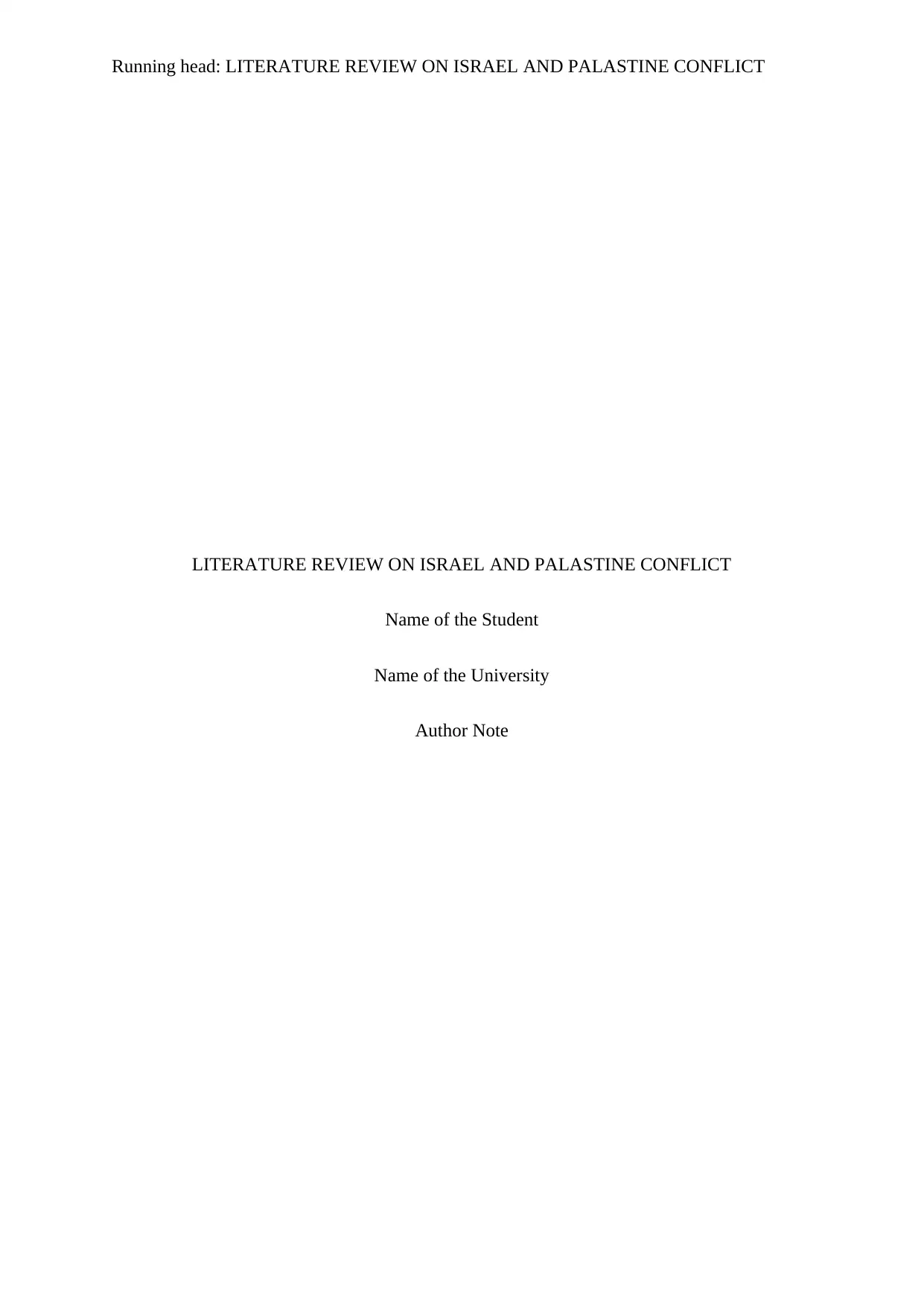
Running head: LITERATURE REVIEW ON ISRAEL AND PALASTINE CONFLICT
LITERATURE REVIEW ON ISRAEL AND PALASTINE CONFLICT
Name of the Student
Name of the University
Author Note
LITERATURE REVIEW ON ISRAEL AND PALASTINE CONFLICT
Name of the Student
Name of the University
Author Note
Paraphrase This Document
Need a fresh take? Get an instant paraphrase of this document with our AI Paraphraser
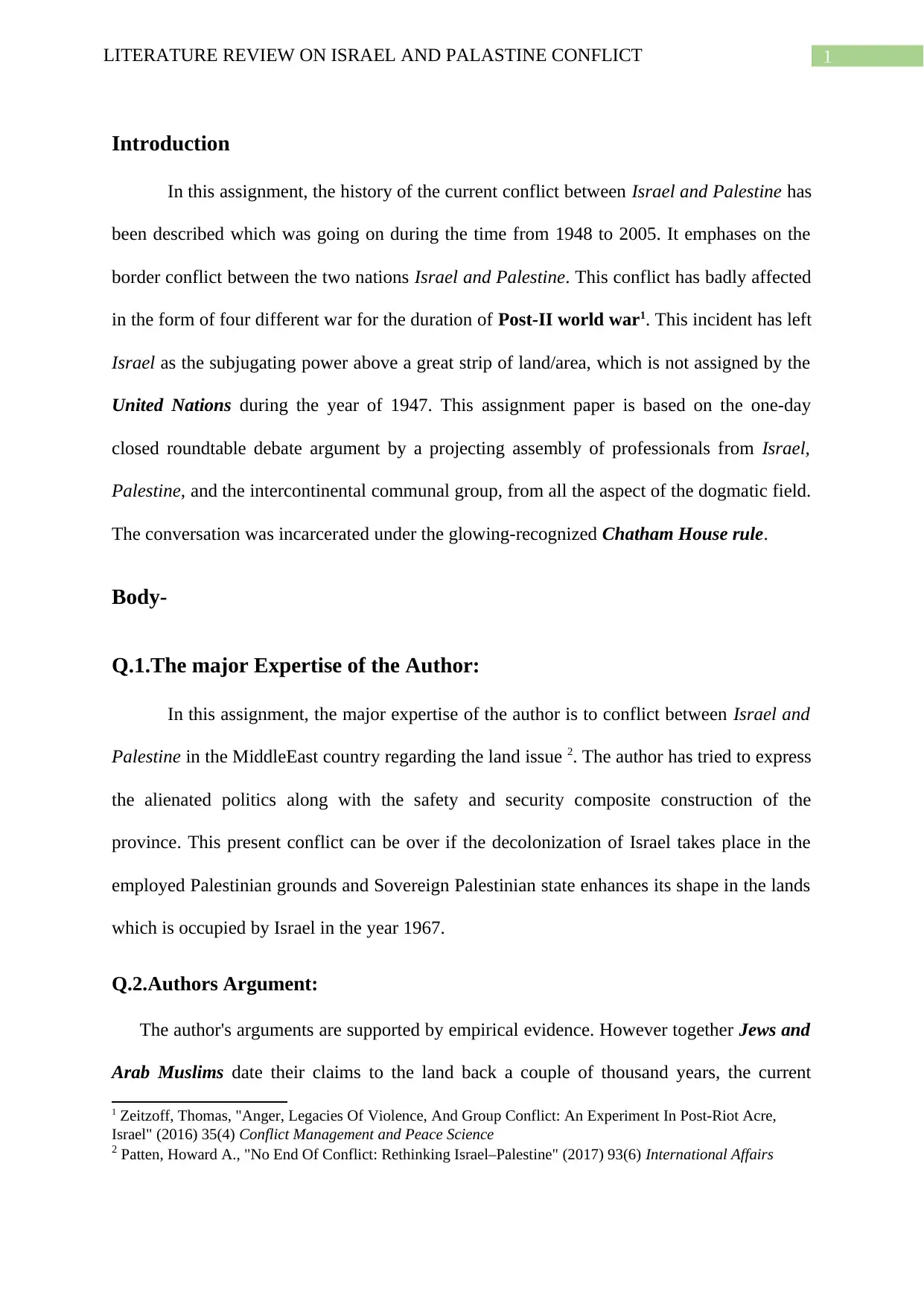
1LITERATURE REVIEW ON ISRAEL AND PALASTINE CONFLICT
Introduction
In this assignment, the history of the current conflict between Israel and Palestine has
been described which was going on during the time from 1948 to 2005. It emphases on the
border conflict between the two nations Israel and Palestine. This conflict has badly affected
in the form of four different war for the duration of Post-II world war1. This incident has left
Israel as the subjugating power above a great strip of land/area, which is not assigned by the
United Nations during the year of 1947. This assignment paper is based on the one‐day
closed roundtable debate argument by a projecting assembly of professionals from Israel,
Palestine, and the intercontinental communal group, from all the aspect of the dogmatic field.
The conversation was incarcerated under the glowing-recognized Chatham House rule.
Body-
Q.1.The major Expertise of the Author:
In this assignment, the major expertise of the author is to conflict between Israel and
Palestine in the MiddleEast country regarding the land issue 2. The author has tried to express
the alienated politics along with the safety and security composite construction of the
province. This present conflict can be over if the decolonization of Israel takes place in the
employed Palestinian grounds and Sovereign Palestinian state enhances its shape in the lands
which is occupied by Israel in the year 1967.
Q.2.Authors Argument:
The author's arguments are supported by empirical evidence. However together Jews and
Arab Muslims date their claims to the land back a couple of thousand years, the current
1 Zeitzoff, Thomas, "Anger, Legacies Of Violence, And Group Conflict: An Experiment In Post-Riot Acre,
Israel" (2016) 35(4) Conflict Management and Peace Science
2 Patten, Howard A., "No End Of Conflict: Rethinking Israel–Palestine" (2017) 93(6) International Affairs
Introduction
In this assignment, the history of the current conflict between Israel and Palestine has
been described which was going on during the time from 1948 to 2005. It emphases on the
border conflict between the two nations Israel and Palestine. This conflict has badly affected
in the form of four different war for the duration of Post-II world war1. This incident has left
Israel as the subjugating power above a great strip of land/area, which is not assigned by the
United Nations during the year of 1947. This assignment paper is based on the one‐day
closed roundtable debate argument by a projecting assembly of professionals from Israel,
Palestine, and the intercontinental communal group, from all the aspect of the dogmatic field.
The conversation was incarcerated under the glowing-recognized Chatham House rule.
Body-
Q.1.The major Expertise of the Author:
In this assignment, the major expertise of the author is to conflict between Israel and
Palestine in the MiddleEast country regarding the land issue 2. The author has tried to express
the alienated politics along with the safety and security composite construction of the
province. This present conflict can be over if the decolonization of Israel takes place in the
employed Palestinian grounds and Sovereign Palestinian state enhances its shape in the lands
which is occupied by Israel in the year 1967.
Q.2.Authors Argument:
The author's arguments are supported by empirical evidence. However together Jews and
Arab Muslims date their claims to the land back a couple of thousand years, the current
1 Zeitzoff, Thomas, "Anger, Legacies Of Violence, And Group Conflict: An Experiment In Post-Riot Acre,
Israel" (2016) 35(4) Conflict Management and Peace Science
2 Patten, Howard A., "No End Of Conflict: Rethinking Israel–Palestine" (2017) 93(6) International Affairs
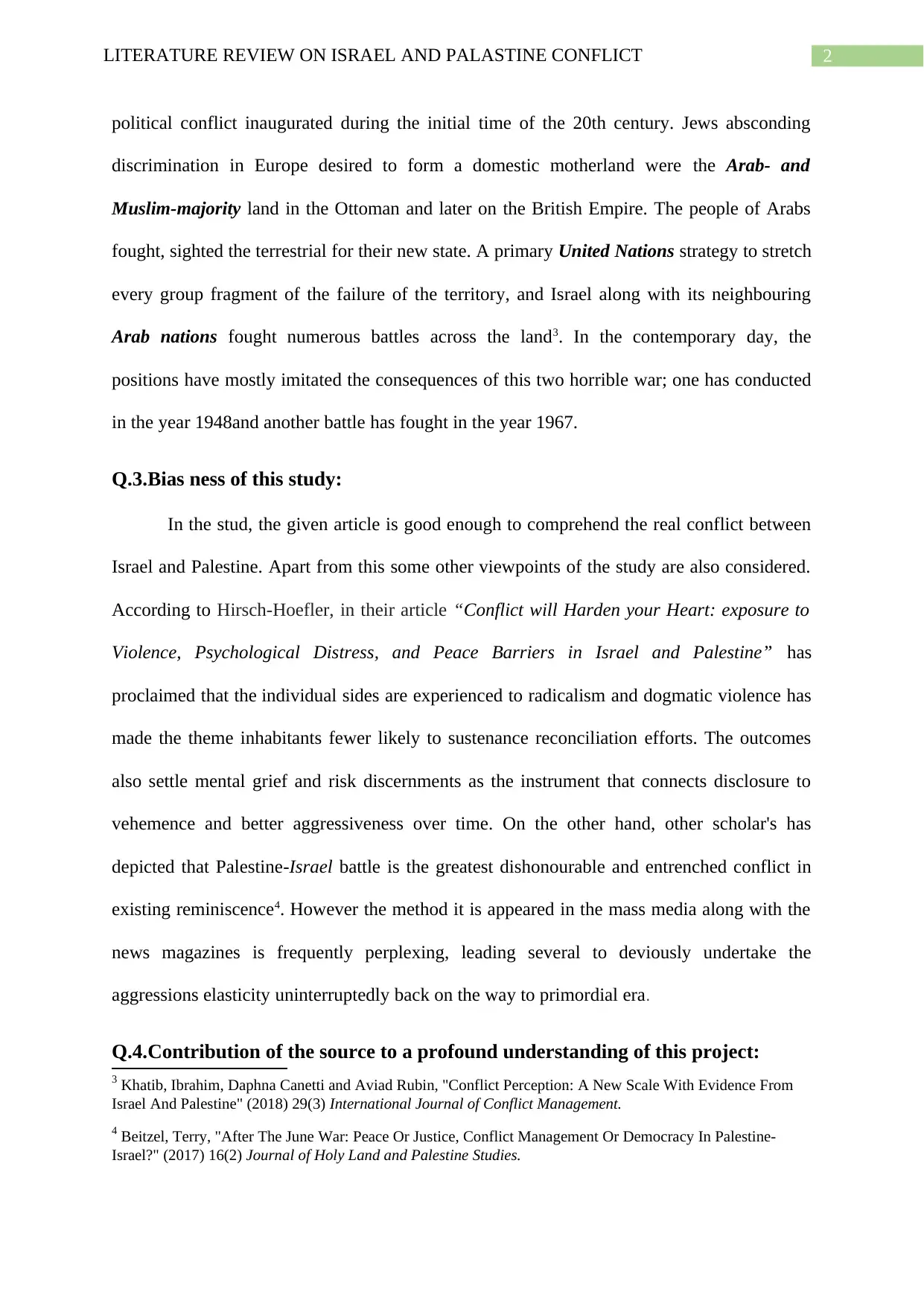
2LITERATURE REVIEW ON ISRAEL AND PALASTINE CONFLICT
political conflict inaugurated during the initial time of the 20th century. Jews absconding
discrimination in Europe desired to form a domestic motherland were the Arab- and
Muslim-majority land in the Ottoman and later on the British Empire. The people of Arabs
fought, sighted the terrestrial for their new state. A primary United Nations strategy to stretch
every group fragment of the failure of the territory, and Israel along with its neighbouring
Arab nations fought numerous battles across the land3. In the contemporary day, the
positions have mostly imitated the consequences of this two horrible war; one has conducted
in the year 1948and another battle has fought in the year 1967.
Q.3.Bias ness of this study:
In the stud, the given article is good enough to comprehend the real conflict between
Israel and Palestine. Apart from this some other viewpoints of the study are also considered.
According to Hirsch-Hoefler, in their article “Conflict will Harden your Heart: exposure to
Violence, Psychological Distress, and Peace Barriers in Israel and Palestine” has
proclaimed that the individual sides are experienced to radicalism and dogmatic violence has
made the theme inhabitants fewer likely to sustenance reconciliation efforts. The outcomes
also settle mental grief and risk discernments as the instrument that connects disclosure to
vehemence and better aggressiveness over time. On the other hand, other scholar's has
depicted that Palestine-Israel battle is the greatest dishonourable and entrenched conflict in
existing reminiscence4. However the method it is appeared in the mass media along with the
news magazines is frequently perplexing, leading several to deviously undertake the
aggressions elasticity uninterruptedly back on the way to primordial era.
Q.4.Contribution of the source to a profound understanding of this project:
3 Khatib, Ibrahim, Daphna Canetti and Aviad Rubin, "Conflict Perception: A New Scale With Evidence From
Israel And Palestine" (2018) 29(3) International Journal of Conflict Management.
4 Beitzel, Terry, "After The June War: Peace Or Justice, Conflict Management Or Democracy In Palestine-
Israel?" (2017) 16(2) Journal of Holy Land and Palestine Studies.
political conflict inaugurated during the initial time of the 20th century. Jews absconding
discrimination in Europe desired to form a domestic motherland were the Arab- and
Muslim-majority land in the Ottoman and later on the British Empire. The people of Arabs
fought, sighted the terrestrial for their new state. A primary United Nations strategy to stretch
every group fragment of the failure of the territory, and Israel along with its neighbouring
Arab nations fought numerous battles across the land3. In the contemporary day, the
positions have mostly imitated the consequences of this two horrible war; one has conducted
in the year 1948and another battle has fought in the year 1967.
Q.3.Bias ness of this study:
In the stud, the given article is good enough to comprehend the real conflict between
Israel and Palestine. Apart from this some other viewpoints of the study are also considered.
According to Hirsch-Hoefler, in their article “Conflict will Harden your Heart: exposure to
Violence, Psychological Distress, and Peace Barriers in Israel and Palestine” has
proclaimed that the individual sides are experienced to radicalism and dogmatic violence has
made the theme inhabitants fewer likely to sustenance reconciliation efforts. The outcomes
also settle mental grief and risk discernments as the instrument that connects disclosure to
vehemence and better aggressiveness over time. On the other hand, other scholar's has
depicted that Palestine-Israel battle is the greatest dishonourable and entrenched conflict in
existing reminiscence4. However the method it is appeared in the mass media along with the
news magazines is frequently perplexing, leading several to deviously undertake the
aggressions elasticity uninterruptedly back on the way to primordial era.
Q.4.Contribution of the source to a profound understanding of this project:
3 Khatib, Ibrahim, Daphna Canetti and Aviad Rubin, "Conflict Perception: A New Scale With Evidence From
Israel And Palestine" (2018) 29(3) International Journal of Conflict Management.
4 Beitzel, Terry, "After The June War: Peace Or Justice, Conflict Management Or Democracy In Palestine-
Israel?" (2017) 16(2) Journal of Holy Land and Palestine Studies.
⊘ This is a preview!⊘
Do you want full access?
Subscribe today to unlock all pages.

Trusted by 1+ million students worldwide
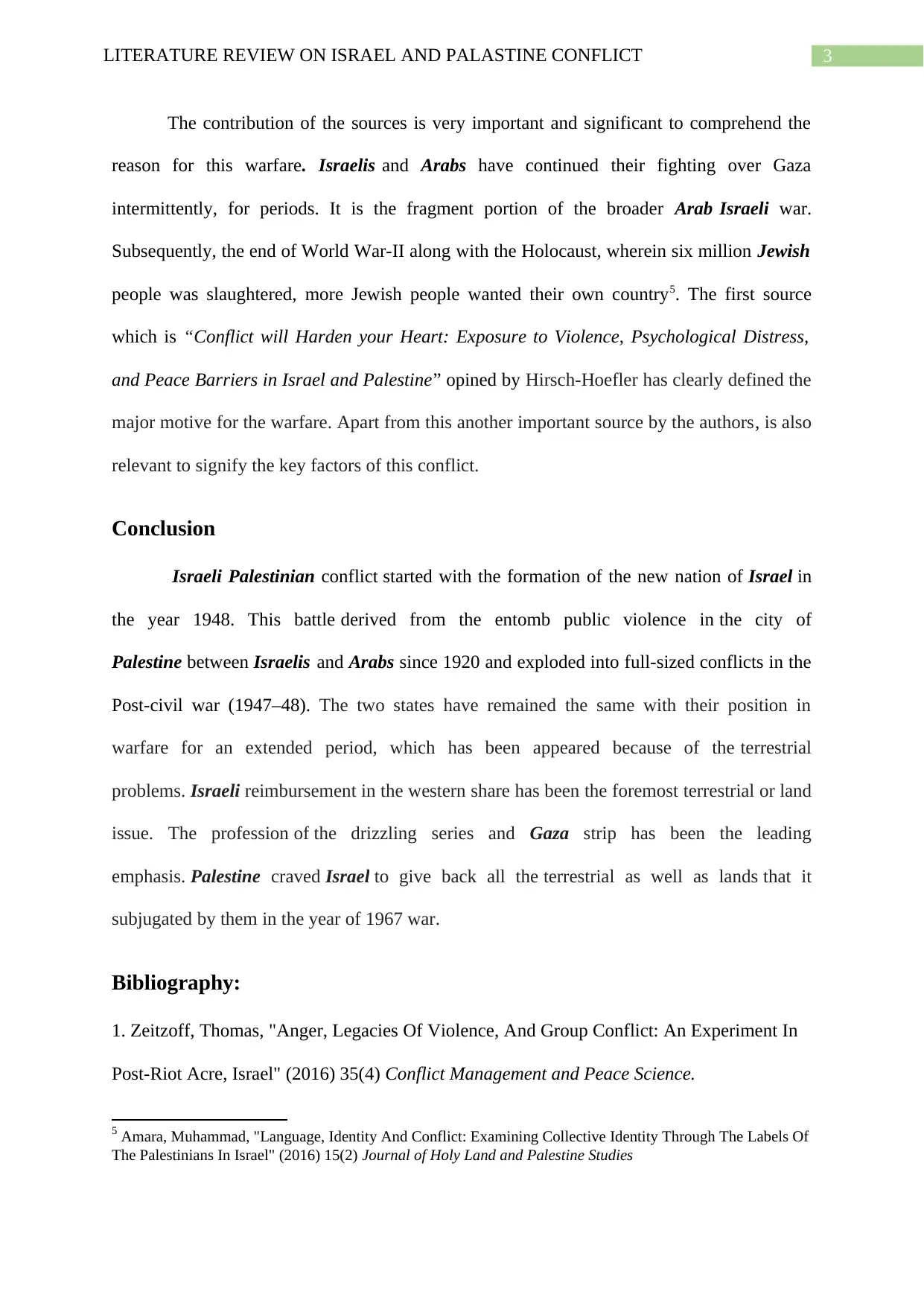
3LITERATURE REVIEW ON ISRAEL AND PALASTINE CONFLICT
The contribution of the sources is very important and significant to comprehend the
reason for this warfare. Israelis and Arabs have continued their fighting over Gaza
intermittently, for periods. It is the fragment portion of the broader Arab Israeli war.
Subsequently, the end of World War-II along with the Holocaust, wherein six million Jewish
people was slaughtered, more Jewish people wanted their own country5. The first source
which is “Conflict will Harden your Heart: Exposure to Violence, Psychological Distress,
and Peace Barriers in Israel and Palestine” opined by Hirsch-Hoefler has clearly defined the
major motive for the warfare. Apart from this another important source by the authors, is also
relevant to signify the key factors of this conflict.
Conclusion
Israeli Palestinian conflict started with the formation of the new nation of Israel in
the year 1948. This battle derived from the entomb public violence in the city of
Palestine between Israelis and Arabs since 1920 and exploded into full-sized conflicts in the
Post-civil war (1947–48). The two states have remained the same with their position in
warfare for an extended period, which has been appeared because of the terrestrial
problems. Israeli reimbursement in the western share has been the foremost terrestrial or land
issue. The profession of the drizzling series and Gaza strip has been the leading
emphasis. Palestine craved Israel to give back all the terrestrial as well as lands that it
subjugated by them in the year of 1967 war.
Bibliography:
1. Zeitzoff, Thomas, "Anger, Legacies Of Violence, And Group Conflict: An Experiment In
Post-Riot Acre, Israel" (2016) 35(4) Conflict Management and Peace Science.
5 Amara, Muhammad, "Language, Identity And Conflict: Examining Collective Identity Through The Labels Of
The Palestinians In Israel" (2016) 15(2) Journal of Holy Land and Palestine Studies
The contribution of the sources is very important and significant to comprehend the
reason for this warfare. Israelis and Arabs have continued their fighting over Gaza
intermittently, for periods. It is the fragment portion of the broader Arab Israeli war.
Subsequently, the end of World War-II along with the Holocaust, wherein six million Jewish
people was slaughtered, more Jewish people wanted their own country5. The first source
which is “Conflict will Harden your Heart: Exposure to Violence, Psychological Distress,
and Peace Barriers in Israel and Palestine” opined by Hirsch-Hoefler has clearly defined the
major motive for the warfare. Apart from this another important source by the authors, is also
relevant to signify the key factors of this conflict.
Conclusion
Israeli Palestinian conflict started with the formation of the new nation of Israel in
the year 1948. This battle derived from the entomb public violence in the city of
Palestine between Israelis and Arabs since 1920 and exploded into full-sized conflicts in the
Post-civil war (1947–48). The two states have remained the same with their position in
warfare for an extended period, which has been appeared because of the terrestrial
problems. Israeli reimbursement in the western share has been the foremost terrestrial or land
issue. The profession of the drizzling series and Gaza strip has been the leading
emphasis. Palestine craved Israel to give back all the terrestrial as well as lands that it
subjugated by them in the year of 1967 war.
Bibliography:
1. Zeitzoff, Thomas, "Anger, Legacies Of Violence, And Group Conflict: An Experiment In
Post-Riot Acre, Israel" (2016) 35(4) Conflict Management and Peace Science.
5 Amara, Muhammad, "Language, Identity And Conflict: Examining Collective Identity Through The Labels Of
The Palestinians In Israel" (2016) 15(2) Journal of Holy Land and Palestine Studies
Paraphrase This Document
Need a fresh take? Get an instant paraphrase of this document with our AI Paraphraser
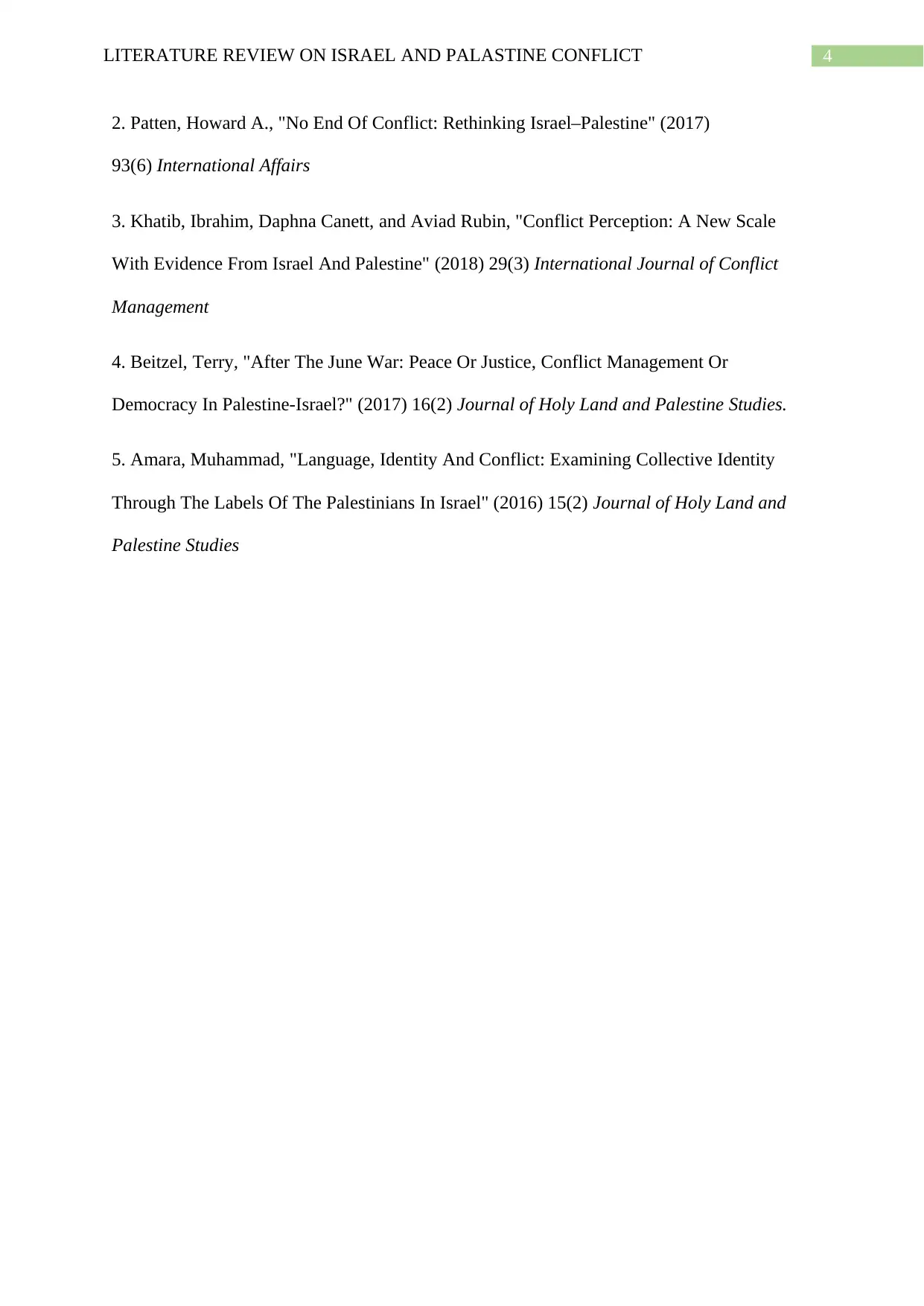
4LITERATURE REVIEW ON ISRAEL AND PALASTINE CONFLICT
2. Patten, Howard A., "No End Of Conflict: Rethinking Israel–Palestine" (2017)
93(6) International Affairs
3. Khatib, Ibrahim, Daphna Canett, and Aviad Rubin, "Conflict Perception: A New Scale
With Evidence From Israel And Palestine" (2018) 29(3) International Journal of Conflict
Management
4. Beitzel, Terry, "After The June War: Peace Or Justice, Conflict Management Or
Democracy In Palestine-Israel?" (2017) 16(2) Journal of Holy Land and Palestine Studies.
5. Amara, Muhammad, "Language, Identity And Conflict: Examining Collective Identity
Through The Labels Of The Palestinians In Israel" (2016) 15(2) Journal of Holy Land and
Palestine Studies
2. Patten, Howard A., "No End Of Conflict: Rethinking Israel–Palestine" (2017)
93(6) International Affairs
3. Khatib, Ibrahim, Daphna Canett, and Aviad Rubin, "Conflict Perception: A New Scale
With Evidence From Israel And Palestine" (2018) 29(3) International Journal of Conflict
Management
4. Beitzel, Terry, "After The June War: Peace Or Justice, Conflict Management Or
Democracy In Palestine-Israel?" (2017) 16(2) Journal of Holy Land and Palestine Studies.
5. Amara, Muhammad, "Language, Identity And Conflict: Examining Collective Identity
Through The Labels Of The Palestinians In Israel" (2016) 15(2) Journal of Holy Land and
Palestine Studies
1 out of 5
Related Documents
Your All-in-One AI-Powered Toolkit for Academic Success.
+13062052269
info@desklib.com
Available 24*7 on WhatsApp / Email
![[object Object]](/_next/static/media/star-bottom.7253800d.svg)
Unlock your academic potential
Copyright © 2020–2025 A2Z Services. All Rights Reserved. Developed and managed by ZUCOL.





